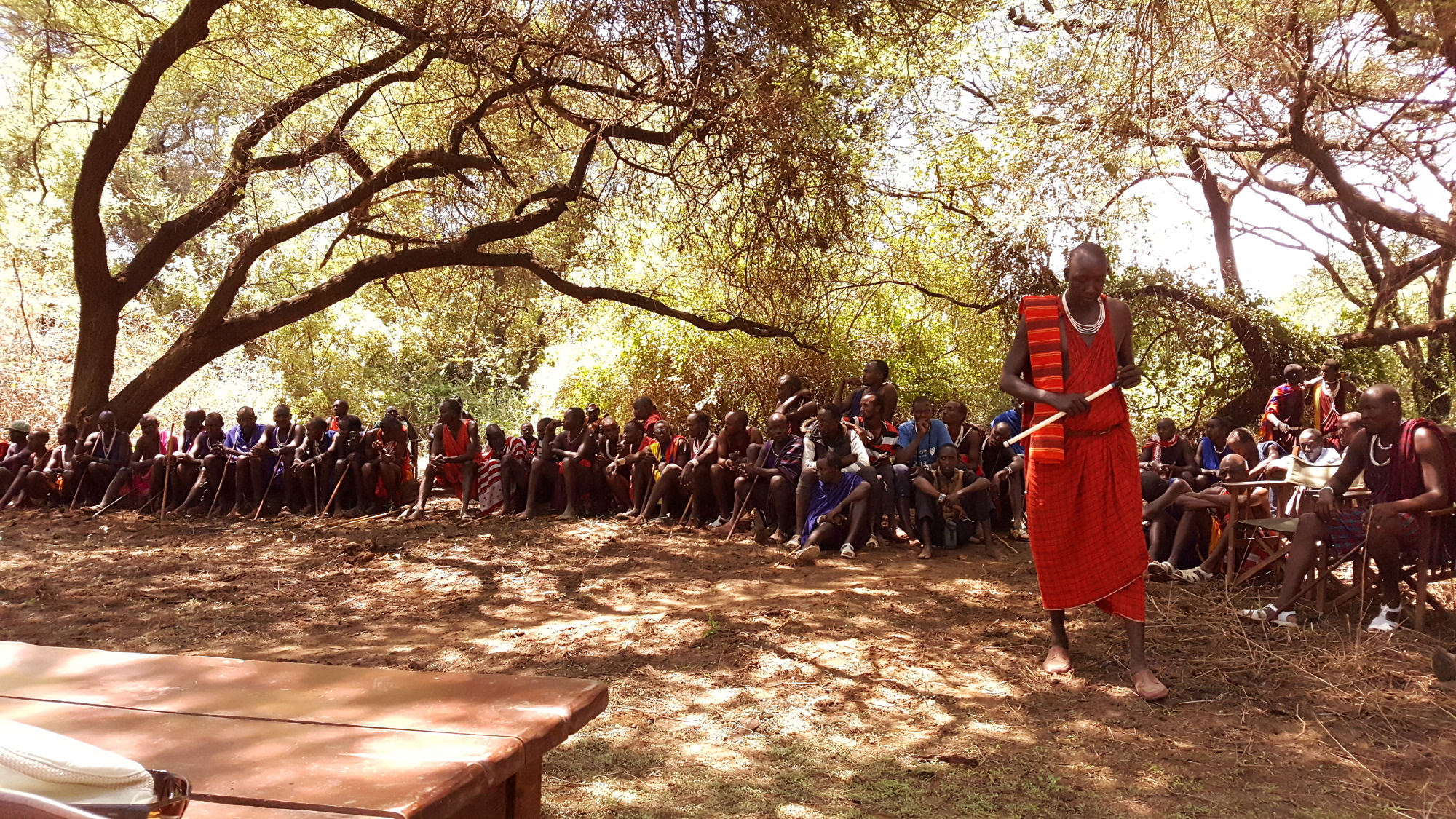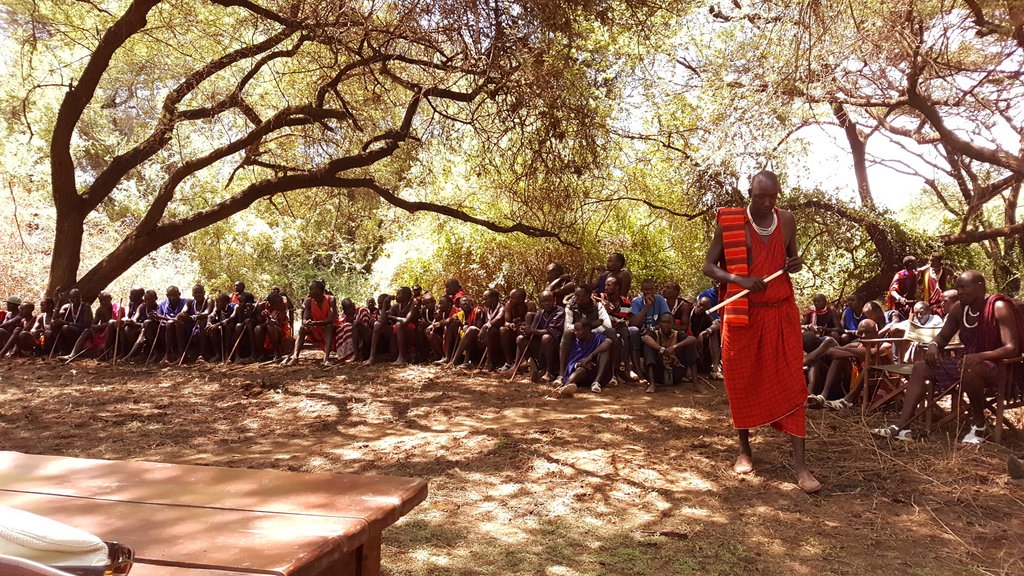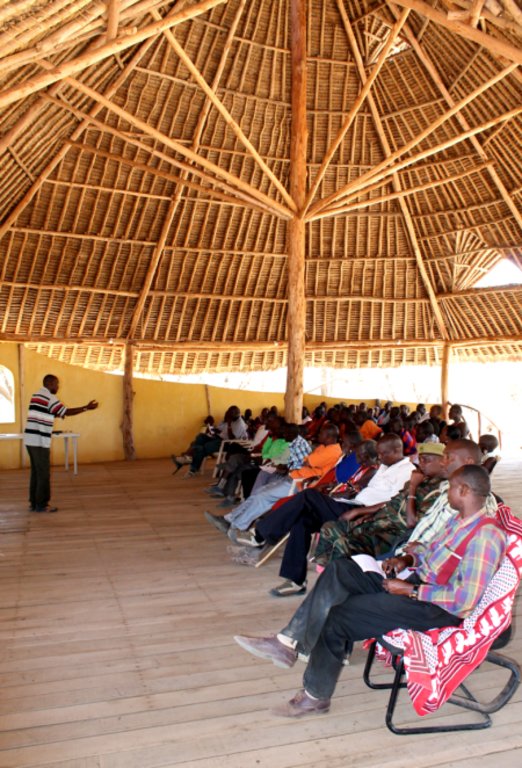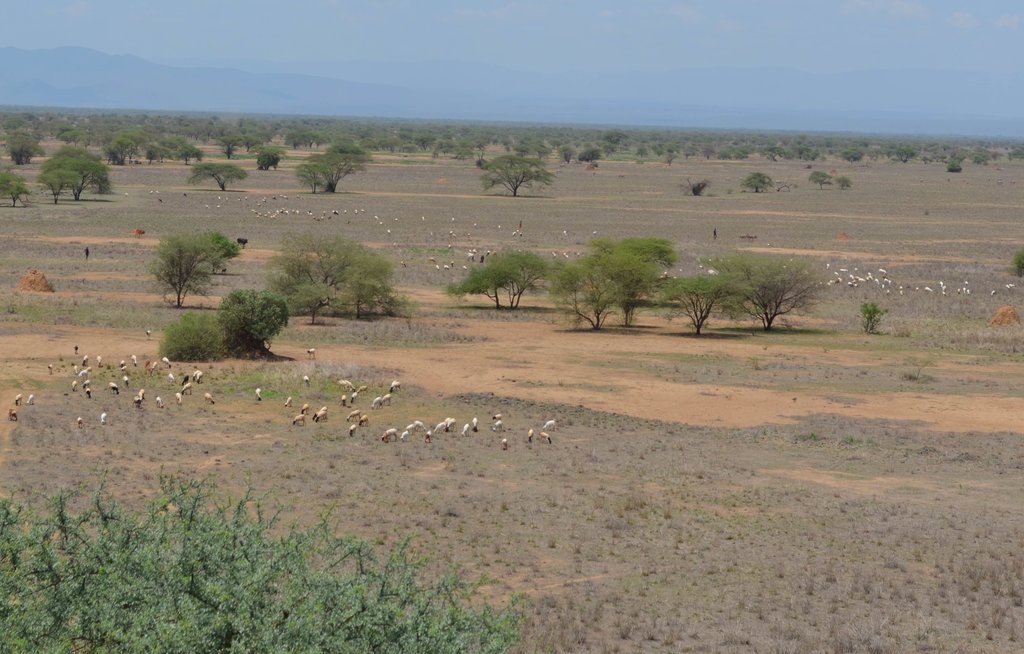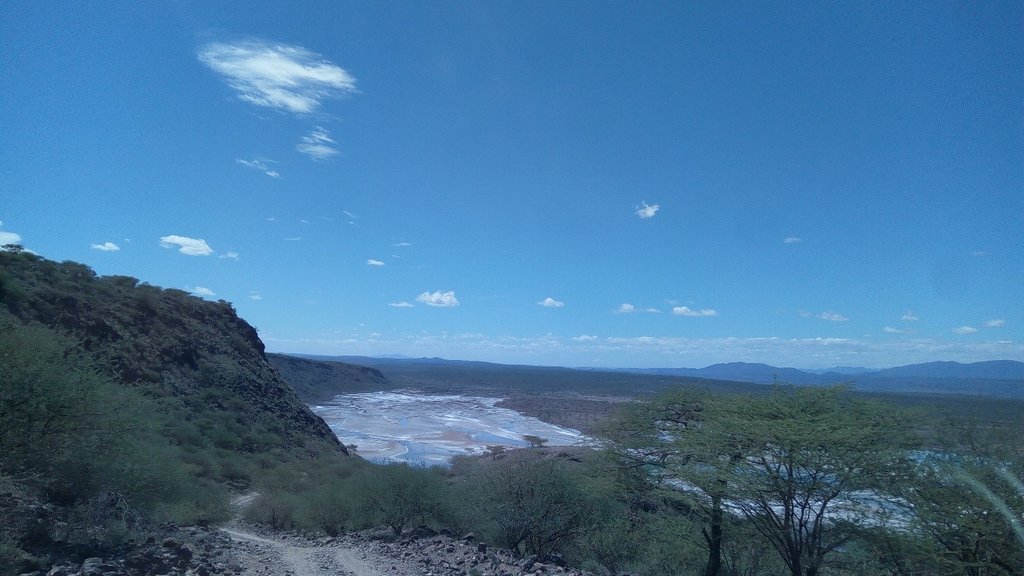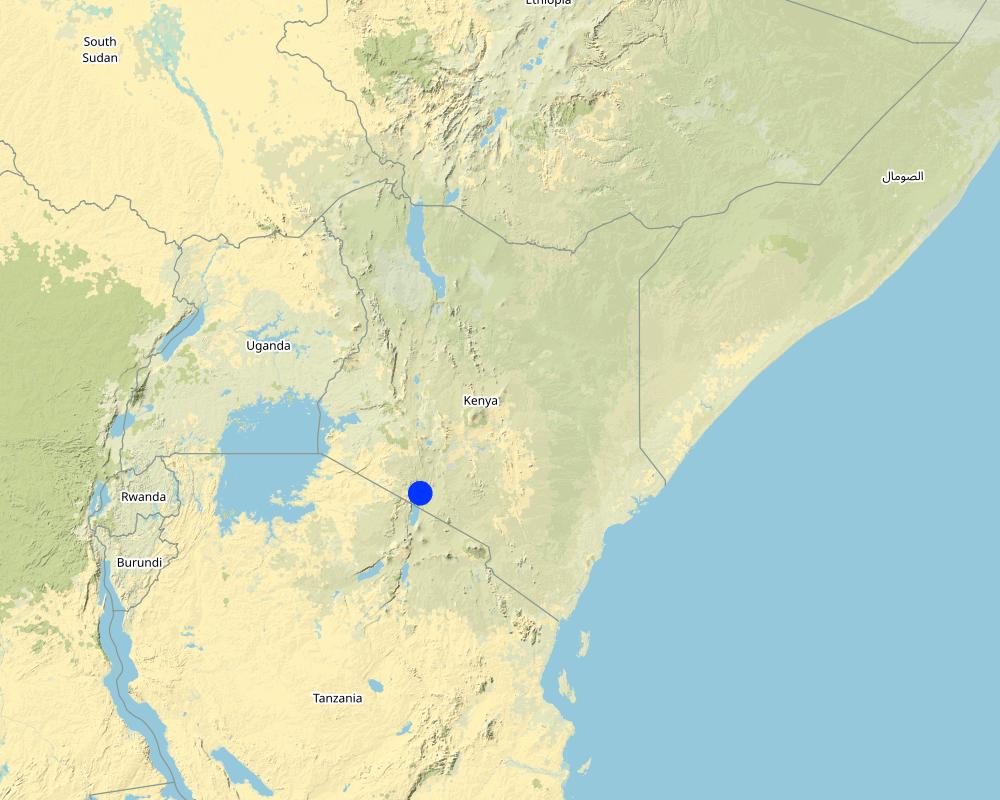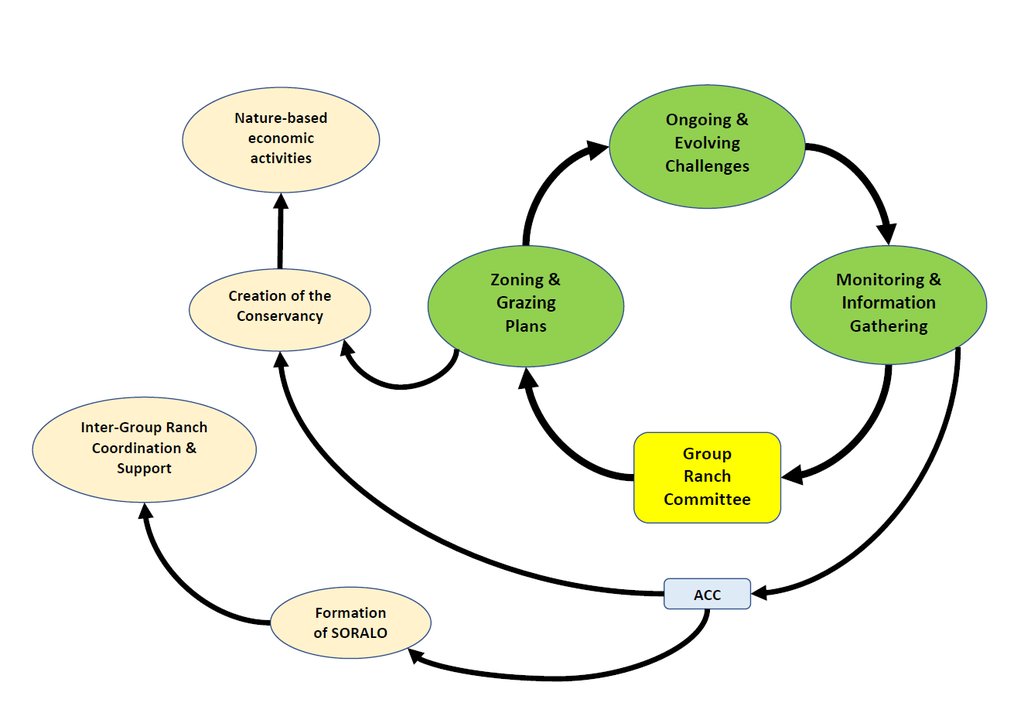Community-based rangeland management in the southern Kenyan rangelands [ເຄັນຢາ]
- ການສ້າງ:
- ປັບປູງ:
- ຜູ້ສັງລວມຂໍ້ມູນ: Lance W. Robinson
- ບັນນາທິການ: Enoch Mobisa, Peter Tyrrell
- ຜູ້ທົບທວນຄືນ: Alexandra Gavilano, Rima Mekdaschi Studer, Hanspeter Liniger, Donia Mühlematter, Simone Verzandvoort, Joana Eichenberger
approaches_3321 - ເຄັນຢາ
- ສະຫຼຸບສັງລວມຢ່າງທັງໝົດທີ່ເປັນ PDF
- ສັງລວມເປັນບົດ PDF ເພື່ອສັ່ງພິມ
- ສັງລວມເປັນບົດ ຢູ່ໃນ browser
- ບົດສະຫຼຸບ ສະບັບເຕັມ (ບໍ່ມີແບບຟອມ)
- Community-based rangeland management in the southern Kenyan rangelands: March 13, 2018 (inactive)
- Community-based rangeland management in the southern Kenyan rangelands: April 20, 2018 (inactive)
- Community-based rangeland management in the southern Kenyan rangelands: June 22, 2018 (inactive)
- Community-based rangeland management in the southern Kenyan rangelands: Nov. 2, 2021 (public)
ເບິ່ງພາກສ່ວນ
ຂະຫຍາຍທັງໝົດ ຍຸບທັງໝົດ1. ຂໍ້ມູນທົ່ວໄປ
1.2 ລາຍລະອຽດ ການຕິດຕໍ່ ຂອງບຸກຄົນທີ່ຊັບພະຍາກອນ ແລະ ສະຖາບັນ ການມີສ່ວນຮ່ວມ ໃນການປະເມີນຜົນ ແລະ ເອກະສານ ຂອງວິທີທາງ
ຊື່ຂອງໂຄງການ ທີ່ອໍານວຍຄວາມສະດວກ ໃນການສ້າງເອກກະສານ ຫຼື ປະເມີນດ້ານແນວທາງ (ຖ້າກ່ຽວຂ້ອງ)
Restoration of degraded land for food security and poverty reduction in East Africa and the Sahel: taking successes in land restoration to scale (ILRI)ຊື່ຂອງໂຄງການ ທີ່ອໍານວຍຄວາມສະດວກ ໃນການສ້າງເອກກະສານ ຫຼື ປະເມີນດ້ານແນວທາງ (ຖ້າກ່ຽວຂ້ອງ)
Book project: Guidelines to Rangeland Management in Sub-Saharan Africa (Rangeland Management)ຊື່ຂອງ ສະຖາບັນການຈັດຕັ້ງ ທີ່ອໍານວຍຄວາມສະດວກ ໃນການສ້າງເອກກະສານ ຫຼື ປະເມີນແນວທາງ (ຖ້າກ່ຽວຂ້ອງ)
International Livestock Research Institute (ILRI) - ເຄັນຢາ1.3 ເງື່ອນໄຂ ຂອງການນໍາໃຊ້ເອກກະສານຂໍ້ມູນ ຂອງ WOCAT
ເມື່ອໃດທີ່ໄດ້ສັງລວມຂໍ້ມູນ (ຢູ່ພາກສະໜາມ)?
01/10/2017
ຜູ້ສັງລວມ ແລະ ບັນດາຜູ້ຕອບແບບສອບຖາມ ຍອມຮັບໃນເງື່ອນໄຂ ການນໍາໃຊ້ຂໍ້ມູນເອກະສານ ທີ່ສ້າງຂື້ນ ໂດຍຜ່ານ ອົງການ WOCAT:
ແມ່ນ
1.4 ເອກະສານອ້າງອີງ (ຫຼາຍ) ກັບແບບສອບຖາມ (ຫຼາຍ) ເຕັກໂນໂລຢີ ຂອງດ້ານການຄຸ້ມຄອງ ດິນແບບຍືນຍົງ
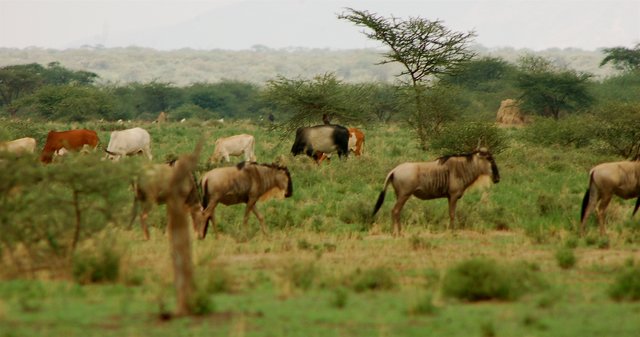
Ecosystem-wide seasonal grazing management in community land [ເຄັນຢາ]
Livestock movements are managed through community governance systems to maintain spatial and temporal heterogeneity of pasture, creating a gradient of quality and quantity of pasture across the landscape. This is achieved through clearly designated seasonal grazing areas for livestock and tight controls on settlement areas, grazing patterns and water points. …
- ຜູ້ສັງລວມຂໍ້ມູນ: Peter Tyrrell
2. ພັນລະນາ ແນວທາງການຄຸ້ມຄອງນໍາໃຊ້ດິນແບບຍືນຍົງ
2.1 ການອະທິບາຍ ໂດຍຫຍໍ້ ຂອງວິທີທາງ
Olkiramatian Group Ranch strengthened the capacity of its community governance structures and began to engage in more rigorous implementation of seasonal grazing plans. This was based on traditional ecological knowledge and rangeland management practices. The group ranch incorporated conservation, research, and joint rangeland management planning with neighboring communities.
2.2 ການອະທິບາຍ ລາຍລະອຽດ ຂອງວິທີທາງ
ການອະທິບາຍ ລາຍລະອຽດ ຂອງວິທີທາງ:
Prior to implementation of the approach described here, rangeland management was carried out through customary institutions supported by a group ranch committee. However, many challenges hindered effective management of livestock and natural resources. These included:
• Poor financial management
• Lack of accountability from the leaders - and lack of demand for accountability from the members
• Conflicting group and individual interests
• Lack of a written constitution and grazing by-laws to reinforce traditional decision making.
To minimize and overcome some of these weaknesses, the African Conservation Centre (ACC), a conservation NGO and Southern Rift Association of Land Owners (SORALO), a Maasai land trust, worked with Olkiramatian and other communities to help them strengthen their planning and governance and to reinvigorate the traditional system of grazing management. Initially, ACC worked with the community’s governance and resource management committees to build local capacity for decision-making and resource management. Institutions previously responsible for resource management, which had existed under traditional systems, had begun to weaken from both internal and external pressures, undermining the long-term sustainability and equity of rangeland management. The group ranch emerged as the key modern institution within this community and needed to be strengthened to support traditional management. To do this several sequential steps were taken:
(i) First, the group ranch committee instituted a more objective way of identifying and electing office holders, to ensure a credible base for resource governance and building consensus among resource users;
(ii) Registration of group ranch members was re-initiated to ensure equal access and rights to resource use, and to provide clarity around membership;
(iii) Institutions responsible for rangeland management, including the group ranch committee, and the conservation and grazing subcommittees, were reinforced primarily through the strengthening of internal capacity;
(iv) ACC facilitated a process for consolidating the group ranch's governance and by-laws to help guide the implementation of the strategy, including enforcement;
(v) The group ranch implemented provisions for holding leaders accountable, allowing the group ranch members to demand their rights;
(vi) Decision-making processes were facilitated by laying down procedures for sharing information and apportioning responsibilities among the leadership - as decided at annual general meetings;
(vii) Rangeland monitoring groups and rangers, mostly local youth, were trained and positioned;
(viii) Finally, the Lale’enok Resource Centre was established, together with community enterprises based on the use of natural resources. A women’s group was included.
An important catalyst in the approach was the establishment of a community conservation area and lodge within the group ranch for the development of wildlife tourism. The conservation area capitalized on the existence of the community’s dry season reserve where wildlife such as zebra and giraffes were abundant , which is only grazed by livestock after pasture is utilized elsewhere. This creation of a conservation area, coupled with the desire to generate revenue through tourism with its semi-exclusive access rights to parts of the conservation area, worked to reaffirm the traditional grazing management strategies by preventing settlement within the conservation area and encouraging longer resting of pasture following rain. This happened alongside the development of a research program , which has helped to put community rangeland management on an evidence-based foundation.
With guidance, the community revised its grazing plan and zoned its land into four resource use areas, now embodied in the new group ranch constitution:
- Conservation or wildlife areas (which then allowed the creation of the conservancy);
- Agricultural/crop production areas;
- Livestock grazing areas (dry season and wet grazing areas);
- Human settlements.
The grazing sub-committee of the group ranch makes and implements decisions on livestock access to certain areas, with pasture rested between and across seasons. The conservancy is rested from livestock grazing as a “grass bank” during the wet seasons, which can last up to 6 months . Settlement areas are also tightly managed under this approach to preserve pasture heterogeneity and prevent local degradation. Fines are imposed on herders who break grazing regulations. On a rolling basis the communities now utilize traditional ecological knowledge, ecological monitoring and expert knowledge, to reassess these grazing regimes under changing conditions. These rangeland management activities are also nested within joint, inter-community planning such as regular meetings of the grazing committees of clusters of group ranches.
2.3 ຮູບພາບຂອງແນວທາງ
2.5 ປະເທດ / ເຂດ / ສະຖານທີ່ບ່ອນທີ່ແນວທາງໄດ້ຖືກນໍາໃຊ້
ປະເທດ:
ເຄັນຢາ
ພາກພື້ນ / ລັດ / ແຂວງ:
Kajiado
ຂໍ້ມູນເພີ່ມເຕີມຂອງສະຖານທີ່:
Kajiado West Constituency
Map
×2.6 ວັນທີເລີ່ມຕົ້ນ ແລະ ສິ້ນສຸດ ການຈັດຕັ້ງປະຕີບັດ ວິທີທາງ
ສະແດງປີຂອງການເລີ່ມຕົ້ນ:
2004
ຄວາມຄິດເຫັນ:
The approach is on-going.
2.7 ປະເພດຂອງແນວທາງ
- Hybrid traditional/project-based
2.8 ເປົ້າໝາຍ / ຈຸດປະສົງຫຼັກ ຂອງການຈັດຕັ້ງປະຕິບັດ ວິທີທາງ
To enhance sustainable livelihoods for pastoralist community members through informed, sustainable use of their resources in an equitable manner.
2.9 ເງື່ອນໄຂອໍານວຍ ຫຼື ຂັດຂວາງການປະຕິບັດຂອງເຕັກໂນໂລຢີ / ເຕັກໂນໂລຢີການນໍາໃຊ້ຕາມແນວທາງ
ສັງຄົມ / ວັດທະນະທໍາ / ມາດຕະຖານ ແລະ ຄຸນຄ່າທາງສາສະໜາ
- ອໍານວຍ
Uniform ethnicity. Communal land tenure. The pre-existing customary institutions and the group ranch committees. The government decree on the establishment of group ranches. The strong traditional and cultural knowledge about rangeland and livestock management.
- ເຊື່ອງຊ້ອນ
Cultural beliefs: large numbers of livestock are seen as a status symbol; resulting in potential overstocking of livestock.
ມີຄວາມສາມາດ / ເຂັ້າເຖິງຊັບພະຍາກອນດ້ານການເງິນ ແລະ ການບໍລິການ
- ເຊື່ອງຊ້ອນ
Financial resources are limited for the group ranch committee; they depend on small collections at local markets and some donor financing to enact projects.
ການກໍ່ຕັ້ງສະຖາບັນ
- ອໍານວຍ
The group ranch was already established and practicing planned grazing according to customary rules.
ກ່ຽວກັບກົດໝາຍ (ສິດນໍາໃຊ້ດິນ, ສິດນໍາໃຊ້ນໍ້າ)
- ອໍານວຍ
There is a strong body of legislation developing in Kenya to ensure sustainable use of rangeland resources. This includes the new Community Land Act (2016), which creates local governance institutions with protection of grazing; the Wildlife Act (2012), creating community conservation areas and allowing benefits and compensation from wildlife; the Water Act (2016) and the Water Resource Users Association encourage multi-user analysis and cooperation to protect the quantity and quality of water for all users within a catchment.
ການປົກຄອງທີ່ດິນ (ການຕັດສິນໃຈ, ການປະຕິບັດ ແລະ ຂໍ້ບັງຄັບ)
- ອໍານວຍ
The group ranch committee is the highest decision-making body. There is a grazing sub-committee which manages the details of seasonal grazing patterns.
ຄວາມຮູ້ກ່ຽວກັບການຄຸ້ມຄອງ ທີ່ດິນແບບຍືນຍົງ, ການເຂົ້າເຖິງການສະໜັບສະໜູນ ທາງດ້ານວິຊາການ
- ອໍານວຍ
The community is networked to researchers and technical experts from institutions including ACC, SORALO, Universities and TATA chemicals; through the Lale'enok Resource Centre. Mobile phones and access to internet has enhanced access to technical information. There is a wealth of traditional knowledge within the older generation who understand the requirements for sustainable management of the landscape.
- ເຊື່ອງຊ້ອນ
Low capacity of the many community members to tap into the existing knowledge bases. Lack of technical capacity to address specific research needs identified by the community.
ຕະຫຼາດ (ໃນການຊື້ວັດຖຸດິບ, ຂາຍຜະລິດຕະພັນ) ແລະ ລາຄາ
- ອໍານວຍ
Livestock markets within reach of the community members - the Shompole crossborder livestock market is in the neighboring conservancy.
- ເຊື່ອງຊ້ອນ
Low livestock prices at the grassroots present a challenge to the growth of the livestock value chain. A solution may be the facilitation of more direct market linkages.
ວຽກ, ມີກໍາລັງຄົນ
- ອໍານວຍ
The community members are involved in the process as part of their lifestyle. Planned grazing made it easier for them to take of their livestock and reduce the number of people required to herd their livestock.
3. ການມີສ່ວນຮ່ວມ ແລະ ບົດບາດຂອງພາກສ່ວນທີ່ກ່ຽວຂ້ອງທີ່ໄດ້ມີສ່ວນຮ່ວມ
3.1 ຜູ້ມີສ່ວນຮ່ວມ ໃນວິທີທາງ ແລະ ພາລະບົດບາດ ຂອງເຂົາເຈົ້າ
- ຜູ້ນໍາໃຊ້ດິນໃນທ້ອງຖິ່ນ / ຊຸມຊົນທ້ອງຖິ່ນ
Members and executives of the group ranch committee.
Individual members of the group ranch, as rangeland users and through their grazing patterns according to the ranch's grazing plans, contribute to management.
- ອົງການຈັດຕັ້ງ ພາຍໃນຊຸມຊົນ
Olkiramatian Group Ranch.
The group ranch, through its democratic structures, has the ultimate responsibility for decision-making for the group ranch, including rangeland management and grazing planning, partnerships, fund raising and financial management, etc.
- ຜູ້ຊ່ຽວຊານ ການນຄຸ້ມຄອງ ທີ່ດິນແບບຍືນຍົງ / ທີ່ປຶກສາດ້ານກະສິກໍາ
Personnel of SORALO and ACC.
Provision of technical advice and support.
- ນັກຄົ້ນຄວ້າ
Students.
Students, both Kenyan and international, hosted by SORALO and ACC, carry out research on conservation, ecotourism, land use, rangeland condition, etc.
- ອົງການຈັດຕັ້ງ ທີ່ບໍ່ຂື້ນກັບລັດຖະບານ
SORALO and ACC.
Research guidance, and connection with other government, NGO and donor agency stakeholders. Also provision of technical advice and support (see SLM Specialists/Agricultural Advisers, above).
ຖ້າຫາກມີຫຼາຍພາກສ່ວນທີ່ເຂົ້າຮ່ວມ ໃຫ້ລະບຸ ອົງການທີ່ເປັນຫຼັກ ໃນການຈັດຕັ້ງປະຕິບັດ:
Olkiramatian Group Ranch
3.2 ການມີສ່ວນຮ່ວມຂອງຜູ້ນໍາໃຊ້ທີ່ດິນໃນທ້ອງຖິ່ນ / ຊຸມຊົນທ້ອງຖິ່ນໃນໄລຍະທີ່ແຕກຕ່າງກັນຂອງແນວທາງ
| ການລວບລວມ ເອົາຜູ້ນໍາໃຊ້ດິນ ໃນທ້ອງຖິ່ນ / ຊຸມຊົນທ້ອງຖິ່ນ | ໃຫ້ລະບຸ ຜູ້ໃດທີ່ມີສ່ວນຮ່ວມ ໃນແຕ່ລະກິດຈະກໍາ? | |
|---|---|---|
| ການເລີ່ມຕົ້ນ / ແຮງຈູງໃຈ | ການນໍາໃໍຊ້ເອງ | The community invited ACC to come and support conservation work and improve ecotourism. A visiting researcher from ACC identified opportunities for reinvigorating the group ranch structure and nature-based enterprises. The work of the researcher contributed to the approach, but the ultimate push came from the community. |
| ການວາງແຜນ | ການນໍາໃໍຊ້ເອງ | The community evolved into an organized group and was determined to employ good resource practices to improve the rangelands and the lives of the people. They sought the help of ACC in strengthening their capacity to fundraise and improve community enterprises. SORALO was established to continue supporting the community in networking and supporting the conservation work. |
| ການປະຕິບັດ | ການຮ່ວມມື | The committee members, the individual members implement the approach. SORALO and to a less extent ACC, play advisory roles. The community members provide labour and time as their in-kind contribution. ACC help the community raise funds for the implementation. |
| ຕິດຕາມກວດກາ / ການປະເມີນຜົນ | ການຮ່ວມມື | With guidance from SORALO, monitoring is done by community members. The various committees have a monitoring component in their work. |
| Research | ການຮ່ວມມື | At the beginning, research was done by a scientist from ACC. Later on in the approach, the community youth have been trained and are actively involved in research activities. |
3.3 ແຜນວາດ (ຖ້າມີ)
ການອະທິບາຍ:
Adaptation to evolving challenges through the community's governance structure -- the group ranch committee -- is at the centre of the approach.
ຜູ້ຂຽນ:
Enoch Ontiri and Lance Robinson
3.4 ການຕັດສິນໃຈກ່ຽວກັບການຄັດເລືອກເຕັກໂນໂລຢີຂອງການຄຸ້ມຄອງທີ່ດິນແບບຍືນຍົງ / ເຕັກໂນໂລຢີ
ລະບຸ ຄົນທີ່ຕັດສິນໃຈ ກ່ຽວກັບການຄັດເລືອກຂອງ ເຕັກໂນໂລຢີ / ເຕັກໂນໂລຢີ ຈະໄດ້ຮັບການປະຕິບັດ:
- ຜູ້ນໍາໃຊ້ທີ່ດິນຫຼັກ, ການສະໜັບສະໜູນ ໂດຍຜູ້ຊ່ຽວຊານ ການນໍາໃຊ້ທີ່ດິນແບບຍືນຍົງ
ອະທິບາຍ:
The group ranch members are the collective owners and, through the Group Ranch Committee, managers of the land. They receive support and guidance from organizations such as the African Conservation Centre (ACC) and Southern Rift Association of Land Owners (SORALO) on techniques and practices to apply, but are themselves the primary decision-makers.
- Research and evidence-based decision-making played some role, but planning of technical practices to be implemented was primarily based on traditional knowledge
4. ການສະໜັບສະໜູນທາງດ້ານວິຊາການ, ການສ້າງຄວາມສາມາດ, ແລະ ການຈັດການຄວາມຮູ້.
4.1 ການສ້າງຄວາມສາມາດ / ການຝຶກອົບຮົມ
ຜູ້ນໍາໃຊ້ທີ່ດິນ ຫຼື ພາກສ່ວນກ່ຽວຂ້ອງອື່ນໆ ໄດ້ຮັບການຝຶກອົບຮົມບໍ່?
ແມ່ນ
ໃຫ້ລະບຸ ຜູ້ໃດທີ່ໄດ້ຮັບການຝຶກອົບຮົມ:
- ຜູ້ນໍາໃຊ້ດິນ
ຖ້າເປັນໄປໄດ້, ໃຫ້ລະບຸເພດ, ອາຍຸ, ສະຖານະພາບ, ຊົນເຜົ່າ, ແລະ ອື່ນໆ:
Training was carried out primarily for group ranch committee members and other community leaders/elders, predominantly males. Training has also been done for the RETO Women's Group.
ຮູບແບບຂອງການຝຶກອົບຮົມ:
- Training workshops
ໃນຫົວຂໍ້:
The training to the women’s group was on improved bead-making and business management in order to exploit the tourism market.
Selected youth were trained as wildlife rangers and others as rangeland monitors. Species-specific teams were trained in tracking particular species such as lions.
4.2 ການບໍລິການໃຫ້ຄໍາປຶກສາ
ເຮັດຜູ້ໃຊ້ທີ່ດິນມີການເຂົ້າເຖິງການບໍລິການໃຫ້ຄໍາປຶກສາ?
ແມ່ນ
ລະບຸວ່າການສະໜອງ ການບໍລິການ ໃຫ້ຄໍາປຶກສາ:
- ໃນພື້ນທີ່ຂອງຜູ້ນໍາໃຊ້ດິນ
- ສູນຄົ້ນຄວ້າ
ອະທິບາຍ / ຄວາມຄິດເຫັນ:
Advisory services provided by SORALO and ACC. A permanent resource centre, Lale'enok is present in the region.
4.3 ສະຖາບັນການສ້າງຄວາມເຂັ້ມແຂງ (ການພັດທະນາອົງການຈັດຕັ້ງ)
ສະຖາບັນ ໄດ້ຮັບການສ້າງຕັ້ງຂື້ນ ຫຼື ໄດ້ຮັບການສ້າງຄວາມເຂັ້ມແຂງ ໂດຍການຈັດຕັ້ງປະຕິບັດ ວິທີທາງບໍ່?
- ມີ, ພໍສົມຄວນ
ລະບຸ ທາງສະຖາບັນ ໄດ້ສ້າງຄວາມເຂັ້ມແຂງ ໃນລະດັບໃດ (ຫຼາຍ):
- ທ້ອງຖິ່ນ
ອະທິບາຍ ສະຖາບັນການຈັດຕັ້ງ, ພາລະບົດບາດ ແລະ ໜ້າທີ່ຮັບຜິດຊອບ, ສະມາຊິກ ແລະ ອື່ນໆ.
The organizations African Conservation Centre (ACC) and Southern Rift Association of Land Owners (SORALO) have helped to strengthen the group ranch structures
ລະບຸ ປະເພດ ຂອງສະໜັບສະໜູນ:
- ທາງດ້ານການເງິນ
- ການສ້າງຄວາມອາດສາມາດ / ການຝຶກອົບຮົມ
ໃຫ້ລາຍລະອຽດເພີ່ມເຕີມ:
Primarily support has been through capacity building and training with the group ranch committee and other committees.
Additional support has been provided by SORALO through the provision of staff and labor for hosting community meetings; writing the constitution; producing maps and other information; conducting research into pertinent management issues.
ACC with funding from various sources helped to finance establishment of the conservation area and a lodge. The lodge pays a lease fee to the group ranch. Guests at the lodge pay a bed night fee which is paid to the group ranch committee and a conservation fee which goes to the conservation committee. The conservation fee pays for scouts and also finances conservation-related development such as fences, water pipelines, and other community projects.
4.4 ຕິດຕາມກວດກາ ແລະ ປະເມີນຜົນ
ການຈັດຕັ້ງປະຕິບັດ ວິທີທາງ ໄດ້ມີການປະເມີນຜົນ ແລະ ຕິດຕາມບໍ?
ແມ່ນ
ຄວາມຄິດເຫັນ:
The community, especially youth, are involved in assessing the ecological status of the rangeland. There are ecological monitoring units which take censuses of flora and fauna. Community activity reports are written regularly. The major economic activity of livestock trade is monitored by a data collection team that visits the major livestock markets.
ຖ້າແມ່ນ, ເອກກະສານສະບັບນີ້ ແມ່ນໄດ້ນໍາໃຊ້ເຂົ້າໃນການຕິດຕາມ ແລະ ປະເມີນຜົນບໍ່?
ແມ່ນ
4.5 ການຄົ້ນຄວ້າ
ນີ້້ແມ່ນສ່ວນໜຶ່ງ ການຄົ້ນຄວ້າ ຂອງວິທີທາງບໍ່?
ແມ່ນ
ລະບຸ ຫົວຂໍ້:
- ລະບົບນິເວດ
ໃຫ້ຂໍ້ມູນ ເພີ່ມເຕີມ ແລະ ກໍານົດ ຜູ້ໃດເຮັດການຄົ້ນຄວ້າ:
Research questions are often answered by visiting students and local scientists at the Lale'enok Resource Centre. These questions cover a diverse range of issues related to the socioeconomic and ecological factors affecting local livelihoods.
African Conservation Centre. Southern Rift Association of Land Owners. Graduate students hosted by these organizations.
5. ການສະໜັບສະໜູນທາງດ້ານການເງິນ ແລະ ອຸປະກອນຈາກພາຍນອກ
5.1 ງົບປະມານປະຈໍາປີ ສໍາລັບວິທີທາງ ຂອງການຄຸ້ມຄອງ ທີ່ດິນແບບຍືນຍົງ
ຖ້າຫາກບໍ່ຮູ້ຈັດງົບປະມານທີ່ແນ່ນອນ ແມ່ນໃຫ້ປະມານເອົາ:
- < 2,000
ຄໍາເຫັນ (ຕົວຢ່າງ: ແຫຼ່ງຂໍ້ມູນຫຼັກ ຂອງການສະໜອງທຶນ / ຜູ້ໃຫ້ທຶນທີ່ສໍາຄັນ):
The primary resource used for implementation of the approach is the time of community members. Inputs from supporting organizations ACC and SORALO, while relevant, have been secondary to the approach and hence are not included in the budget here.
5.2 ການສະໜັບສະໜູນ ທາງດ້ານການເງິນ / ອຸປະກອນ ສະໜອງໃຫ້ແກ່ຜູ້ນໍາທີ່ດິນ
ຜູ້ນໍາໃຊ້ດິນ ໄດ້ຮັບການສະໜັບສະໜູນ ທາງດ້ານ ການເງິນ / ອຸປະກອນ ໃນການຈັດຕັ້ງປະຕິບັດ ເຕັກໂນໂລຢີບໍ?
ບໍ່ແມ່ນ
5.3 ເງິນສົມທົບສໍາລັບການນໍາໃຊ້ສະເພາະປັດໃຈຂາເຂົ້າໃນການຜະລີດກະສິກໍາ (ລວມທັງແຮງງານ)
- ບໍ່ມີ
ຖ້າແຮງງານ ຂອງຜູ້ນໍາໃຊ້ດິນ ໄດ້ຮັບການສະໜັບສະໜູນ ປັດໃຈຂາເຂົ້າ, ແມ່ນບໍ່:
- ການອາສາ
ຄວາມຄິດເຫັນ:
Implementing the approach is just a lifestyle for the community members.
5.4 ສິນເຊື່ອ
ໄດ້ປ່ອຍສິນເຊື່ອ ສະໜອງໃຫ້ພາຍໃຕ້ ວິທີການສໍາລັບກິດຈະກໍາ ການຄຸ້ມຄອງ ທີ່ດິນແບບຍືນນຍົງບໍ່?
ບໍ່ແມ່ນ
5.5 ສິ່ງຈູງໃຈ ຫຼື ເຄື່ອງມືອື່ນໆ
ການສົ່ງເສີມ ຈັດຕັ້ງປະຕິບັດ ເຕັກໂນໂລຢີ ໃນການຄຸ້ມຄອງ ດິນແບບຍືນຍົງ ໄດ້ສະໜອງສິ່ງກະຕຸກຊຸກຍູ້ບໍ່?
ແມ່ນ
ຖ້າແມ່ນ, ໃຫ້ລະບຸ:
Ecotourism revenue provides some incentive to carry out and continue with rangeland management activities.
6. ວິເຄາະຜົນກະທົບ ແລະ ສັງລວມບັນຫາ
6.1 ຜົນກະທົບຂອງແນວທາງ
ວິທີທາງ ຊ່ວຍຊຸກຍູ້ ຜູ້ນຳໃຊ້ທີ່ດິນທ້ອງຖີ່ນ, ໃນການປັບປຸງ ການມີສ່ວນຮ່ວມ ຂອງຜູ້ທີ່ກ່ຽວຂ້ອງ ບໍ່?
- ບໍ່
- ມີ, ໜ້ອຍໜຶ່ງ
- ມີ, ພໍສົມຄວນ
- ມີ, ຫຼາຍ
ການນໍາໃຊ້ ວິທີທາງ ດັ່ງກ່າວນີ້ ສາມາດເປັນຫຼັກຖານ ທີ່ສະໜັບສະໜູນ ໃຫ້ການຕັດສິນໃຈໄດ້ບໍ່?
- ບໍ່
- ມີ, ໜ້ອຍໜຶ່ງ
- ມີ, ພໍສົມຄວນ
- ມີ, ຫຼາຍ
Ecological monitoring and research are prominent aspects of the interventions and community-decision-making.
ການຈັດຕັ້ງປະຕິບັດ ວິທີທາງ ສາມາດຊ່ວຍຜູ້ນໍາໃຊ້ທີ່ດິນ ໃນການຈັດຕັ້ງປະຕິບັດ ແລະ ບໍາລຸງຮັກສາ ເຕັກໂນໂລຢີ ການຄຸ້ມຄອງ ທີ່ດິນແບບຍືນຍົງໄດ້ບໍ?
- ບໍ່
- ມີ, ໜ້ອຍໜຶ່ງ
- ມີ, ພໍສົມຄວນ
- ມີ, ຫຼາຍ
It facilitated the implementation of seasonal planned grazing.
ການນໍາໃຊ້ ວິທີທາງ ສາມາດປັບປຸງ ການປະສານງານ ແລະ ຄ່າໃຊ້ຈ່າຍ ການຈັດຕັ້ງປະຕິບັດ ທີ່ມີປະສິດທິພາບ ຂອງການຄຸ້ມຄອງ ທີ່ດິນແບບຍືດຍົງໄດ້ບໍ່?
- ບໍ່
- ມີ, ໜ້ອຍໜຶ່ງ
- ມີ, ພໍສົມຄວນ
- ມີ, ຫຼາຍ
Coordination with neighbouring group ranches has been a key aspect of the interventions.
ການນໍາໃຊ້ ວິທີທາງ ສາມາດປັບປຸງຄວາມຮູ້ ແລະ ຄວາມສາມາດຂອງຜູ້ນໍາໃຊ້ທີ່ດິນ ໃນການປະຕິບັດ ການຄຸ້ມຄອງ ທີ່ດິນແບບຍືດຍົງໄດ້ບໍ່?
- ບໍ່
- ມີ, ໜ້ອຍໜຶ່ງ
- ມີ, ພໍສົມຄວນ
- ມີ, ຫຼາຍ
Improved knowledge of rangeland and wildlife ecology.
ການນໍາໃຊ້ ວິທີທາງ ສາມາດຫຼຸດຜ່ອນ ຂໍ້ຂັດແຍ່ງໄດ້ບໍ່?
- ບໍ່
- ມີ, ໜ້ອຍໜຶ່ງ
- ມີ, ພໍສົມຄວນ
- ມີ, ຫຼາຍ
Involvement of customary institutions has contributed to mitigation and resolution of conflicts.
ການຈັດຕັ້ງປະຕິບັດ ວິທີທາງ ສາມາດປັບປຸງ ປະເດັນການຖືຄອງທີ່ດິນ / ສິດທິໃນການນໍາໃຊ້ທີ່ດິນ ທີ່ເຊື່ອງຊ້ອນໃນການຈັດຕັ້ງປະຕິບັດ ເຕັກໂນໂລຢີ ການຄຸ້ມຄອງ ທີ່ດິນແບບຍືນຍົງໄດ້ບໍ?
- ບໍ່
- ມີ, ໜ້ອຍໜຶ່ງ
- ມີ, ພໍສົມຄວນ
- ມີ, ຫຼາຍ
In theory, tenure rights were already secure. However the weakness of the community institution--the group ranch--could have resulted in land fragmentation or alienation as it had done so in many other group ranches. Strengthening the group ranch's governance has strengthened tenure security.
6.2 ແຮງຈູງໃຈຫຼັກຂອງຜູ້ນໍາໃຊ້ທີ່ດິນໃນການປະຕິບັດການຄຸ້ມຄອງທີ່ດິນແບບຍືນຍົງ
- ການຜະລິດເພີ່ມຂຶ້ນ
The rangelands have increased pastures for livestock. Wildlife numbers in the rangeland increased. Ecotourism enterprises improved in the area.
- ກໍາໄລເພີ່ມຂຶ້ນ (ຄວາມສາມາດ), ການປັບປຸງຄ່າໃຊ້ຈ່າຍ, ຜົນປະໂຫຍດ, ອັດຕາສ່ວນ
- ຫຼຸດຜ່ອນດິນເຊື່ອມໂຊມ
Splash erosion was reduced. Some areas that were bare started having regeneration of grass.
- ກົດລະບຽບແລະລະບຽບການ (ລະອຽດ) / ການບັງຄັບໃຊ້
The rules and by-laws were revised and strategies for enforcement were improved. The group ranch, conservation and rangeland monitoring committees were strengthened.
- ຄວາມຮັບຮູ້ ທາງສີ່ງແວດລ້ອມ
Community members are more aware of the role of wildlife and ecosystem on their lives. New women groups, the youth and other community members involved in research projects has improved their awareness.
- ການປັບປຸງ ຄວາມຮູ້ ແລະ ຄວາມສາມາດ ຂອງການຄຸ້ມຄອງ ທີ່ດິນແບບຍືນຍົງ
The community is constantly involved in project work. Skills in ecological monitoring, ecotourism enterprises, rangeland monitoring, lion tracking all help the community members acquire skills.
- ການຫຼຸດຜ່ອນຂໍ້ຂັດແຍ່ງ
The program has enhanced cohesion and more integration of community members. The committees are an avenue for mitigating any disputes and resolving conflict in the community.
6.3 ຄວາມຍືນຍົງຂອງກິດຈະກໍາວິທີທາງ
ຜູ້ນໍາໃຊ້ ທີ່ດິນ ສາມາດສືບຕໍ່ ການຈັດຕັ້ງປະຕິບັດ ຜ່ານວິທີທາງໄດ້ບໍ່ (ໂດຍປາດສະຈາກ ການຊ່ວຍເຫຼືອ ຈາກພາກສ່ວນພາຍນອກ)?
- ແມ່ນ
ຖ້າ ໄດ້, ອະທິບາຍເຫດຜົນ:
The approach is based on ensuring strong, community-led governance. This has been achieved and is likely to be sustained.
6.4 ຈຸດແຂງ / ຂໍ້ດີ ຂອງວິທີທາງ
| ຈຸດແຂງ / ຂໍ້ດີ / ໂອກາດໃນການນໍາໃຊ້ທີ່ດິນ |
|---|
| The approaches emanates from a strong community with a working customary rangeland management structure. Communal ownership of land and the community's sense of belonging and customary (tribal) right of access and use of natural resources all make it easier for the approach to be successful. |
| ຈຸດແຂງ / ຈຸດດີ / ໂອກາດ ຈາກທັດສະນະຂອງຜູ້ປ້ອນຂໍ້ມູນ ຫຼື ບຸກຄົນສຳຄັນ |
|---|
| The approach is a bottom-up one that builds on traditional resource management practices, adapting them to evolving social, economic and biophysical conditions. This contributes to strong sense of community ownership. |
| As a community driven and implemented the approach, the cost is minimal. With the incorporation of the conservation/wildlife tourism component, a secondary source of income for the community structures and some individuals in the community is realized. |
| The climatic conditions that allow extensive livestock production and wildlife is also another advantage for the approach. The landscape lies between Nguruman escarpment on one side, Lake Magadi on the northwestern part and the Amboseli/Mt. Kilimanjaro on the southern part. These contribute to some degree of isolation and protection of influxes of herders from other locations. |
| The demonstrated success of the grazing management practices put in place has led to changed decisions and management practices reinforcing the community's willingness to continue with the system. |
6.5 ຈຸດອ່ອນ / ຂໍ້ເສຍຂອງແນວທາງ ແລະ ວິທີການແກ້ໄຂໃຫ້ເຂົາເຈົ້າ
| ຈຸດອ່ອນ / ຂໍ້ເສຍ / ຄວາມສ່ຽງໃນມູມມອງຂອງຜູ້ນໍາໃຊ້ທີ່ດິນ | ມີວິທີການແກ້ໄຂຄືແນວໃດ? |
|---|---|
| There is concern among some community members about the incorporation of conservation activities potentially leading to restrictions on mobility and access to pastures. | Continued awareness raising about the benefits and pre-empting misunderstandings about the conservation activities. |
| The community success in rangeland management is sometimes viewed as a source of failure. This is because the community holds some customary beliefs and norms that allow for practices like reciprocal grazing by other pastoralists on their land. In the case that Olkiramatian is the best quality grass bank during extended droughts, livestock from other communities flock there and mostly cause overgrazing, degradation, and social conflict. | The idea of SORALO networking all the landowners in the southern rangelands and are helping them establish similar approaches means the whole rangeland in southern Kenya will become a continuous, homogenously managed landscape. |
| ຈຸດອ່ອນ ຫຼື ຂໍ້ເສຍ ຫຼື ຄວາມສ່ຽງ ໃນມຸມມອງຂອງ ຜູ້ສັງລວມຂໍ້ມູນ ຫຼື ບັນດາຜູ້ຕອບແບບສອບຖາມ | ມີວິທີການແກ້ໄຂຄືແນວໃດ? |
|---|---|
| The capacity of the group ranch committee to raise and attract appropriate human and financial resources is low. | Continued training on effective governance and help in putting in place working systems. |
| The stocking rates of livestock per household are not corresponding to the holding capacity of the rangeland. | Continued action research and training of the locals on the need to reduce livestock numbers. |
7. ເອກກະສານອ້າງອີງ ແລະ ຂໍ້ມູນການເຊື່ອມໂຍງ
7.1 ວິທີການ / ແຫຼ່ງຂໍ້ມູນ
- ການສໍາພາດ ຜູ້ນໍາໃຊ້ທີ່ດິນ
12 focus group discussions.
- ສໍາພາດ ຊ່ຽວຊານ ການຄຸ້ມຄອງ ດິນແບບຍືນຍົງ
9 key informant interviews.
- ການລວບລວມ ບົດລາຍງານ ແລະ ເອກະສານອື່ນໆ ທີ່ມີຢູ່ແລ້ວ
peer reviewed journal papers. project reports.
7.2 ເອກະສານທົ່ວໄປທີ່ສາມາດໃຊ້ໄດ້
ຫົວຂໍ້, ຜູ້ຂຽນ, ປີ, ISBN:
Community-based Rangeland Management in Shompole and Olkiramatian Group Ranches. Ontiri, Enoch M. and Lance W. Robinson. 2018.
ມີຢູ່ໃສ?ມູນຄ່າເທົ່າໃດ?
cgspace.cgiar.org -- open access
7.3 ການເຊື່ອມຕໍ່ກັບຂໍ້ມູນທີ່ກ່ຽວຂ້ອງທີ່ສາມາດໃຊ້ອອນໄລນ໌
ຫົວຂໍ້ / ພັນລະນາ:
Seasonal movements of wildlife and livestock in a heterogenous pastoral landscape: Implications for coexistence and community based conservation
URL:
https://www.sciencedirect.com/science/article/pii/S2351989417301075
ຫົວຂໍ້ / ພັນລະນາ:
Lale'enok Resource centre
URL:
https://laleenok.wordpress.com/history/
ຂໍ້ມູນການເຊື່ອມຕໍ່ ແລະ ເນື້ອໃນ
ຂະຫຍາຍທັງໝົດ ຍຸບທັງໝົດການເຊື່ອມຕໍ່

Ecosystem-wide seasonal grazing management in community land [ເຄັນຢາ]
Livestock movements are managed through community governance systems to maintain spatial and temporal heterogeneity of pasture, creating a gradient of quality and quantity of pasture across the landscape. This is achieved through clearly designated seasonal grazing areas for livestock and tight controls on settlement areas, grazing patterns and water points. …
- ຜູ້ສັງລວມຂໍ້ມູນ: Peter Tyrrell
ເນື້ອໃນ
ບໍ່ມີເນື້ອໃນ


